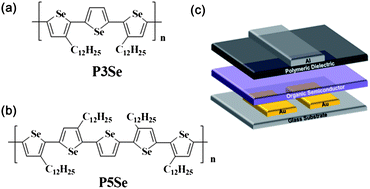Highly stable printed polymer field-effect transistors and inverters via polyselenophene conjugated polymers
Abstract
We report the use of two polyselenophene-based

Maintenance work is planned for Wednesday 1st May 2024 from 9:00am to 11:00am (BST).
During this time, the performance of our website may be affected - searches may run slowly and some pages may be temporarily unavailable. If this happens, please try refreshing your web browser or try waiting two to three minutes before trying again.
We apologise for any inconvenience this might cause and thank you for your patience.
* Corresponding authors
a
Department of Chemical Engineering, Hanbat National University, San 16-1, Dukmyung-dong, Yuseong-gu, Daejeon 305-719, Republic of Korea
E-mail:
yynoh@hanbat.ac.kr
b
Department of Chemistry, The Catholic University of Korea, Bucheon, Gyeonggi-do 420-743, Republic of Korea
E-mail:
inamkang@catholic.ac.kr
c
Heeger Center for Advanced Materials, School of Materials Science and Engineering, Gwangju Institute of Science and Technology (GIST), 261 Cheomdan-gwagiro, Buk-gu, Gwangju 500-712, Republic of Korea
E-mail:
kimdy@gist.ac.kr
d Convergence Components and Materials Research Laboratory, Electronics and Telecommunications Research Institute (ETRI), 218 Gajeongno, Yuseong-gu, Daejeon 305-350, Republic of Korea
We report the use of two polyselenophene-based

 Please wait while we load your content...
Something went wrong. Try again?
Please wait while we load your content...
Something went wrong. Try again?
D. Khim, W. Lee, K. Baeg, D. Kim, I. Kang and Y. Noh, J. Mater. Chem., 2012, 22, 12774 DOI: 10.1039/C2JM16546E
To request permission to reproduce material from this article, please go to the Copyright Clearance Center request page.
If you are an author contributing to an RSC publication, you do not need to request permission provided correct acknowledgement is given.
If you are the author of this article, you do not need to request permission to reproduce figures and diagrams provided correct acknowledgement is given. If you want to reproduce the whole article in a third-party publication (excluding your thesis/dissertation for which permission is not required) please go to the Copyright Clearance Center request page.
Read more about how to correctly acknowledge RSC content.
 Fetching data from CrossRef.
Fetching data from CrossRef.
This may take some time to load.
Loading related content
